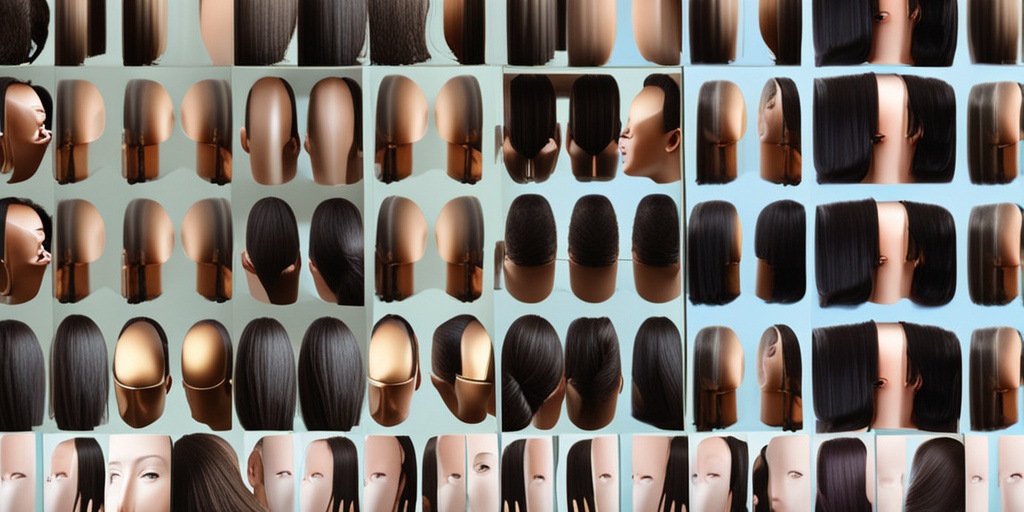What Is Alopecia Circumscripta?
Alopecia circumscripta is a type of hair loss condition that affects millions of people worldwide. Despite its prevalence, many people are still unaware of what it is, how it develops, and how it can be managed. In this article, we’ll delve into the world of alopecia circumscripta, exploring its definition, symptoms, causes, and treatment options.
Definition and Classification
Alopecia circumscripta is a form of alopecia areata, a condition characterized by patchy hair loss on the scalp or elsewhere on the body. The term “circumscripta” means “defined” or “limited,” which refers to the distinct, well-defined patches of hair loss that occur in this condition. Alopecia circumscripta is often considered a mild form of alopecia areata, as the hair loss is typically limited to a small area.
Who Gets Alopecia Circumscripta?
Alopecia circumscripta can affect anyone, regardless of age, gender, or ethnicity. However, it’s more common in people with a family history of autoimmune disorders, such as thyroid disease, rheumatoid arthritis, or lupus. Additionally, people with a history of allergies, asthma, or eczema may be more prone to developing alopecia circumscripta.
Alopecia Circumscripta Symptoms
The symptoms of alopecia circumscripta can vary from person to person, but they often include:
Patchy Hair Loss
The most distinctive symptom of alopecia circumscripta is the sudden appearance of one or more patches of hair loss on the scalp. These patches are usually round or oval in shape and can range in size from a small coin to a larger area.
Hair Loss Patterns
In some cases, the hair loss may follow a specific pattern, such as:
- Banding: Hair loss occurs in a band-like pattern around the scalp.
- Reticular: Hair loss forms a net-like pattern on the scalp.
- Diffuse: Hair loss is widespread and scattered throughout the scalp.
Other Symptoms
In addition to hair loss, people with alopecia circumscripta may experience:
- Itching or burning sensations on the scalp
- Redness or inflammation around the affected area
- Hair thinning or breakage
- Emotional distress or anxiety related to hair loss
If you’re experiencing any of these symptoms, it’s essential to consult a healthcare professional for an accurate diagnosis and guidance on treatment options. Remember, you’re not alone in this journey! 🌟
Stay tuned for the next part of this series, where we’ll explore the causes and treatment options for alopecia circumscripta. In the meantime, if you have any questions or concerns, feel free to reach out to Yesil Health AI (yesilhealth.com) for evidence-based health answers. 💡

Alopecia Circumscripta Causes and Risk Factors
Alopecia circumscripta, a type of alopecia areata, is a condition characterized by patchy hair loss on the scalp or elsewhere on the body. While the exact causes of alopecia circumscripta are still not fully understood, research has identified several factors that may contribute to its development.
Genetic Predisposition
Studies suggest that genetics play a significant role in the development of alopecia circumscripta. People with a family history of autoimmune diseases, such as rheumatoid arthritis, lupus, or thyroid disease, are more likely to develop alopecia circumscripta. Additionally, individuals with a family history of alopecia areata are also at a higher risk of developing the condition.
Autoimmune Response
Alopecia circumscripta is believed to be an autoimmune disease, where the immune system mistakenly attacks healthy hair follicles, leading to hair loss. This autoimmune response may be triggered by various factors, such as stress, hormonal changes, or environmental factors.
Hormonal Imbalance
Hormonal changes, particularly thyroid hormone imbalances, have been linked to the development of alopecia circumscripta. An underactive or overactive thyroid gland can disrupt hair growth, leading to patchy hair loss.
Stress and Trauma
Physical or emotional stress can trigger alopecia circumscripta in some individuals. This may be due to the body’s natural response to stress, which can disrupt hair growth and lead to hair loss.
Viral Infections
Some research suggests that viral infections, such as herpes simplex, may contribute to the development of alopecia circumscripta. However, more studies are needed to confirm this association.
Alopecia Circumscripta Diagnosis
Diagnosing alopecia circumscripta typically involves a combination of physical examination, medical history, and laboratory tests. Here are the common methods used to diagnose alopecia circumscripta:
Physical Examination
A dermatologist or healthcare professional will typically perform a visual examination of the affected area to look for characteristic signs of alopecia circumscripta, such as patchy hair loss, redness, and inflammation.
Medical History
A thorough medical history is essential to identify any underlying conditions that may be contributing to the development of alopecia circumscripta. This includes asking about family history, previous illnesses, and medications.
Laboratory Tests
Laboratory tests, such as blood tests, may be ordered to rule out underlying conditions, such as thyroid disease or autoimmune disorders. A skin scraping or biopsy may also be performed to examine the hair follicles and surrounding tissue.
Differential Diagnosis
Alopecia circumscripta can be mistaken for other conditions, such as alopecia areata, trichotillomania, or tinea capitis. A dermatologist will perform a differential diagnosis to rule out these conditions and confirm the diagnosis of alopecia circumscripta.
Early diagnosis and treatment of alopecia circumscripta can help promote hair regrowth and prevent further hair loss. If you’re experiencing patchy hair loss, it’s essential to consult a dermatologist for an accurate diagnosis and treatment plan 💇♀️.

Alopecia Circumscripta Treatment
Alopecia circumscripta, a type of alopecia areata, can be a challenging condition to treat. However, with the right approach, it is possible to promote hair regrowth and manage symptoms. In this section, we’ll explore the various treatment options available for alopecia circumscripta.
Medications
Several medications can be used to treat alopecia circumscripta. These include:
- Corticosteroids: These medications can help reduce inflammation and suppress the immune system, which can contribute to hair loss. They can be administered topically, orally, or through injections.
- Minoxidil: This medication is commonly used to treat androgenetic alopecia, but it can also be effective in promoting hair growth in people with alopecia circumscripta. It’s available as a topical solution or foam.
- Anthralin: This medication can help promote hair growth by stimulating blood flow to the scalp and reducing inflammation.
Light Therapy
Light therapy, also known as low-level laser therapy (LLLT), has been shown to be effective in promoting hair growth and reducing inflammation. It involves the use of a low-level laser or light-emitting diode (LED) device to stimulate hair follicles.
Platelet-rich Plasma (PRP) Therapy
PRP therapy involves injecting platelet-rich plasma (PRP) into the scalp. PRP is derived from the patient’s own blood and contains growth factors that can stimulate hair growth and improve hair density.
Alopecia Circumscripta Home Remedies
In addition to medical treatments, there are several home remedies that can help promote hair growth and manage symptoms of alopecia circumscripta. Here are some of the most effective ones:
Dietary Changes
Eating a balanced diet rich in vitamins and minerals can help promote hair growth. Foods that are rich in omega-3 fatty acids, zinc, and biotin, such as salmon, walnuts, and eggs, can be particularly beneficial.
Scalp Massage
Massaging the scalp can help increase blood flow and reduce stress, both of which can contribute to hair loss. You can try massaging your scalp with a gentle oil, such as coconut or olive oil, for 5-10 minutes each day.
Aromatherapy
Certain essential oils, such as rosemary and lavender, can help promote hair growth and reduce stress. You can add a few drops of these oils to your shampoo or massage oil for added benefits.
Reduce Stress
Stress is a common trigger for alopecia circumscripta. Practicing stress-reducing techniques, such as meditation, yoga, or deep breathing exercises, can help manage symptoms and promote hair growth.
Remember, it’s essential to consult with a healthcare professional before trying any new treatments or home remedies, especially if you’re already taking medication or have underlying health conditions. With the right approach, it’s possible to manage symptoms and promote hair growth in people with alopecia circumscripta 💇♀️.

Alopecia Circumscripta vs Alopecia Areata
When it comes to hair loss, there are several conditions that can cause it, and two of them are Alopecia Circumscripta and Alopecia Areata. While they share some similarities, they are distinct conditions with different characteristics. In this section, we’ll delve into the differences between Alopecia Circumscripta and Alopecia Areata, helping you understand which one you might be dealing with.
What is Alopecia Areata?
Alopecia Areata is a common autoimmune disease that causes hair loss on the scalp, face, or body. It occurs when the immune system mistakenly attacks healthy hair follicles, leading to hair loss. The exact cause of Alopecia Areata is still unknown, but it’s believed to be triggered by a combination of genetic, environmental, and hormonal factors.
What is Alopecia Circumscripta?
Alopecia Circumscripta, on the other hand, is a rare condition characterized by the sudden loss of hair in a circular or oval-shaped patch. It’s also known as Alopecia Areata Circumscripta, and it’s considered a variant of Alopecia Areata. The main difference between the two is the shape and size of the hair loss patches.
Key Differences
So, what sets Alopecia Circumscripta apart from Alopecia Areata? Here are the key differences:
- Pattern of hair loss: Alopecia Areata can cause hair loss in any shape or size, while Alopecia Circumscripta is characterized by circular or oval-shaped patches.
- Size of hair loss patches: Alopecia Circumscripta patches are typically smaller than those seen in Alopecia Areata.
- Rate of hair loss: Alopecia Circumscripta tends to progress more rapidly than Alopecia Areata.
- Scalp involvement: Alopecia Areata can cause hair loss on the entire scalp, while Alopecia Circumscripta usually affects a localized area.
While both conditions can cause emotional distress and affect a person’s self-esteem, understanding the differences between Alopecia Circumscripta and Alopecia Areata can help you better navigate your treatment options and find the right support. 💇♀️
Alopecia Circumscripta Prognosis
Receiving a diagnosis of Alopecia Circumscripta can be overwhelming, but understanding the prognosis can help you prepare for what’s to come. In this section, we’ll explore the outlook for people with Alopecia Circumscripta and what you can expect in terms of treatment and recovery.
What to Expect
The prognosis for Alopecia Circumscripta varies from person to person, but in general, the condition tends to follow a relapsing-remitting course. This means that hair loss may occur in cycles, with periods of hair growth followed by periods of hair loss.
Treatment Options
While there is no cure for Alopecia Circumscripta, there are several treatment options available to help manage the condition and promote hair growth. These include:
- Corticosteroid injections: To reduce inflammation and promote hair growth.
- Topical treatments: Creams or ointments applied directly to the affected area to stimulate hair growth.
- Light therapy: Exposure to specific wavelengths of light to promote hair growth.
- Wigs and hairpieces: To help cope with hair loss and improve self-esteem.
It’s essential to work with a healthcare professional to determine the best course of treatment for your individual case. With the right treatment and support, it’s possible to manage Alopecia Circumscripta and promote hair growth. 💪
Remember, you’re not alone in this journey. Connecting with others who have experienced Alopecia Circumscripta can provide valuable support and guidance. 💕

Frequently Asked Questions about Alopecia Circumscripta
What is Alopecia Circumscripta?
Alopecia Circumscripta is a type of hair loss condition characterized by the sudden loss of hair in a circular or oval-shaped patch. It is a form of alopecia areata, an autoimmune disease that causes the immune system to attack healthy hair follicles.
What are the symptoms of Alopecia Circumscripta?
The main symptom of Alopecia Circumscripta is the sudden appearance of a circular or oval-shaped patch of hair loss on the scalp. The patch may be smooth and shiny, and may have a clear border around it. In some cases, the hair loss may be accompanied by itching, redness, or inflammation.
What causes Alopecia Circumscripta?
The exact cause of Alopecia Circumscripta is not known, but it is believed to be related to an autoimmune response, where the immune system mistakenly attacks healthy hair follicles. Genetics, stress, and hormonal changes may also play a role in the development of the condition.
How is Alopecia Circumscripta diagnosed?
Alopecia Circumscripta is typically diagnosed through a physical examination of the scalp and a review of the patient’s medical history. A dermatologist may also perform a skin scraping or biopsy to rule out other conditions that may cause similar symptoms.
Can Alopecia Circumscripta be treated?
Yes, Alopecia Circumscripta can be treated with various medications and therapies. Corticosteroid injections, topical creams, and oral medications may be used to reduce inflammation and promote hair growth. In some cases, light therapy or wig therapy may also be recommended.
Will my hair grow back?
In many cases, the hair will grow back on its own within a few months. However, in some cases, the hair loss may be permanent. The likelihood of hair regrowth depends on the severity of the condition and the individual’s overall health.
Is Alopecia Circumscripta contagious?
No, Alopecia Circumscripta is not contagious and cannot be spread from person to person.
Can I prevent Alopecia Circumscripta?
There is no sure way to prevent Alopecia Circumscripta, but reducing stress, maintaining a healthy diet, and getting regular exercise may help reduce the risk of developing the condition.
What is the difference between Alopecia Circumscripta and Poliosis?
Alopecia Circumscripta is a type of hair loss condition, while Poliosis is a condition characterized by the presence of white or gray hair in a specific area of the scalp. While both conditions can cause hair loss, they have distinct causes and symptoms.
Can Alopecia Circumscripta affect anyone?
Alopecia Circumscripta can affect anyone, regardless of age, gender, or ethnicity. However, it is more common in people with a family history of autoimmune diseases.
How does Alopecia Circumscripta affect daily life?
Alopecia Circumscripta can affect a person’s self-esteem and confidence, especially if the hair loss is visible. However, with the right treatment and support, it is possible to manage the condition and lead a normal life.




